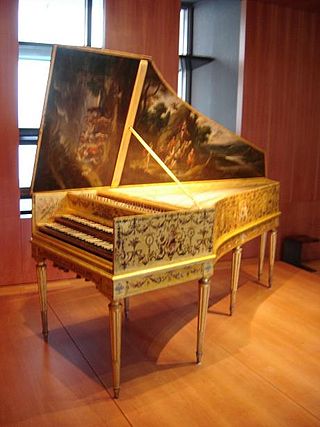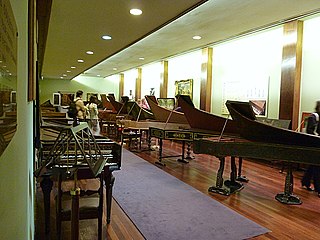
A harpsichord is a musical instrument played by means of a keyboard. This activates a row of levers that turn a trigger mechanism that plucks one or more strings with a small plectrum made from quill or plastic. The strings are under tension on a soundboard, which is mounted in a wooden case; the soundboard amplifies the vibrations from the strings so that the listeners can hear it. Like a pipe organ, a harpsichord may have more than one keyboard manual, and even a pedal board. Harpsichords may also have stop buttons which add or remove additional octaves. Some harpsichords may have a buff stop, which brings a strip of buff leather or other material in contact with the strings, muting their sound to simulate the sound of a plucked lute.
Jacques Duphly was a French harpsichordist and composer.
Jacques Champion de Chambonnières was a French harpsichordist, dancer and composer. Born into a musical family, Chambonnières made an illustrious career as court harpsichordist in Paris and was considered by many of his contemporaries to be one of the greatest musicians in Europe. However, late in life Chambonnières gradually fell out of favor at the court and lost his position. He died in poverty, but at an advanced age, and not before publishing a number of his works. Today Chambonnières is considered one of the greatest representatives of the early French harpsichord school.
The Ruckers family were harpsichord and virginal makers from the Southern Netherlands based in Antwerp in the 16th and 17th century. Their influence stretched well into the 18th century, and to the harpsichord revival of the 20th.

Pascal-Joseph Taskin was a Holy Roman Empire-born French harpsichord and piano maker.

Jean-Henri Hemsch, known in German as Johann Heinrich Hemsch, was a French harpsichord maker of German origin.
Frank Twombly Hubbard was an American harpsichord maker, a pioneer in the revival of historical methods of harpsichord building.

William Richmond Dowd was an American harpsichord maker and one of the most important pioneers of the historical harpsichord movement.
The Dulcken family were Flemish harpsichord makers of German origin.
Jean Germain may refer to:
The Blanchet family were an extended family of French harpsichord-makers from the late-17th century to the mid-19th century, by which time they had become piano makers.
The Kirkman family were English harpsichord and later piano makers of Alsatian origin, active from the 1750s until the late 1800s.

The Couchet family were Flemish harpsichord and virginal makers in Antwerp, closely associated with, and descendants of, the Ruckers family.

The harpsichord was an important keyboard instrument in Europe from the 15th through the 18th centuries, and as revived in the 20th, is widely played today.

Benoist Stehlin was a French harpsichord builder.

Albert Delin was a harpsichord maker in the Austrian Netherlands.

Antoine Vater was a notable harpsichord maker in Paris of German origin.

Raymond Anthony Russell,, was a British organologist and antiquarian. He was an expert on early keyboard instruments, and assembled an important collection which now forms the Raymond Russell Collection of Early Keyboard Instruments of the University of Edinburgh.

The Russell Collection is a substantial collection of early keyboard instruments assembled by the British harpsichordist and organologist Raymond Russell. It forms part of the Musical Instrument Museums collection of the University of Edinburgh, and is housed in St Cecilia's Hall. Its full name is the Raymond Russell Collection of Early Keyboard Instruments.